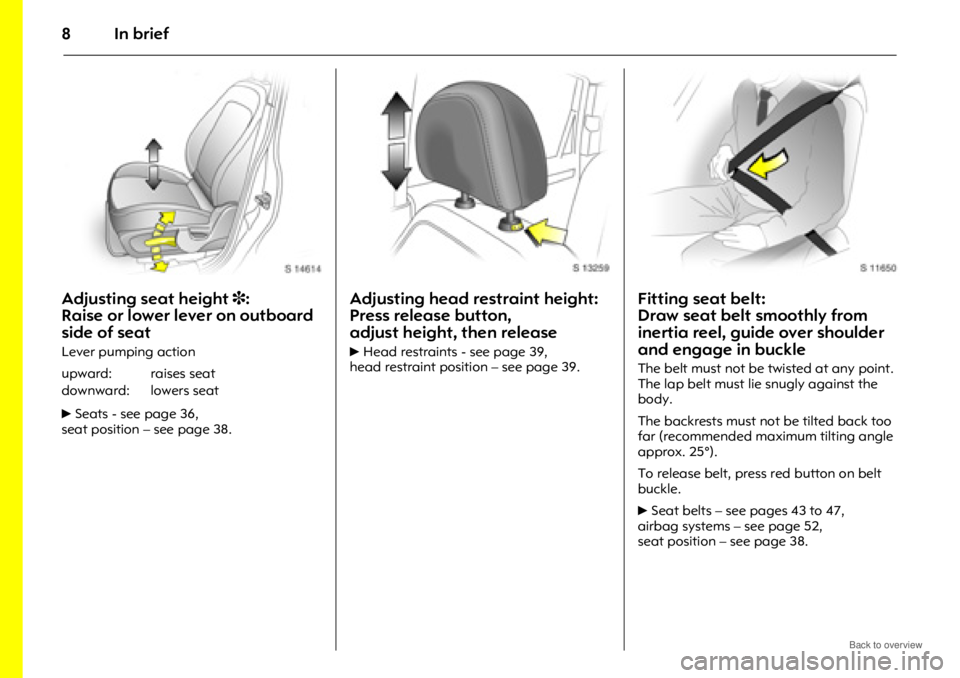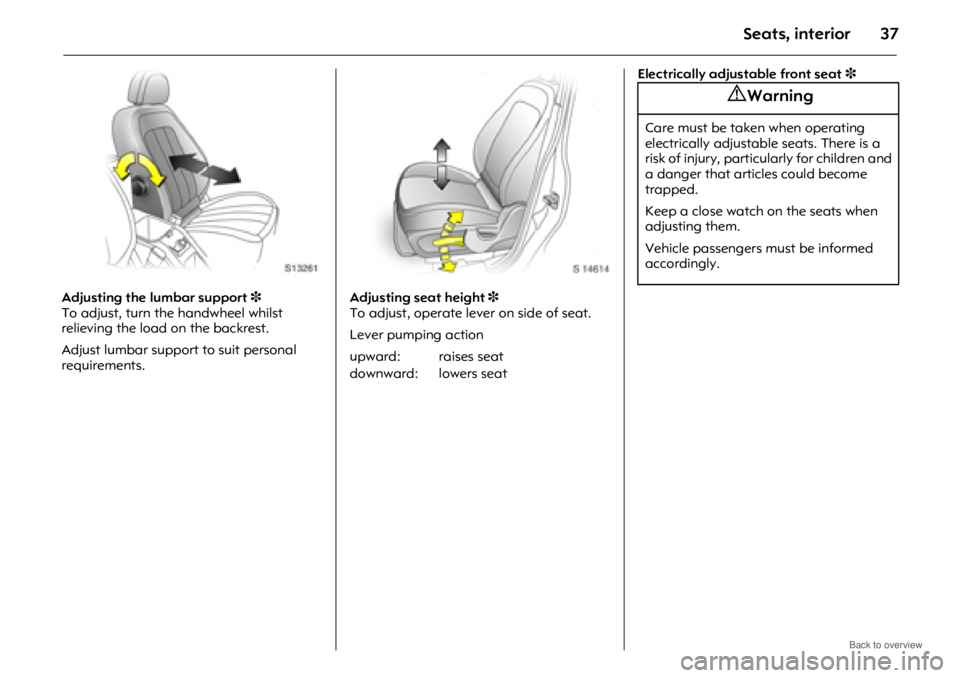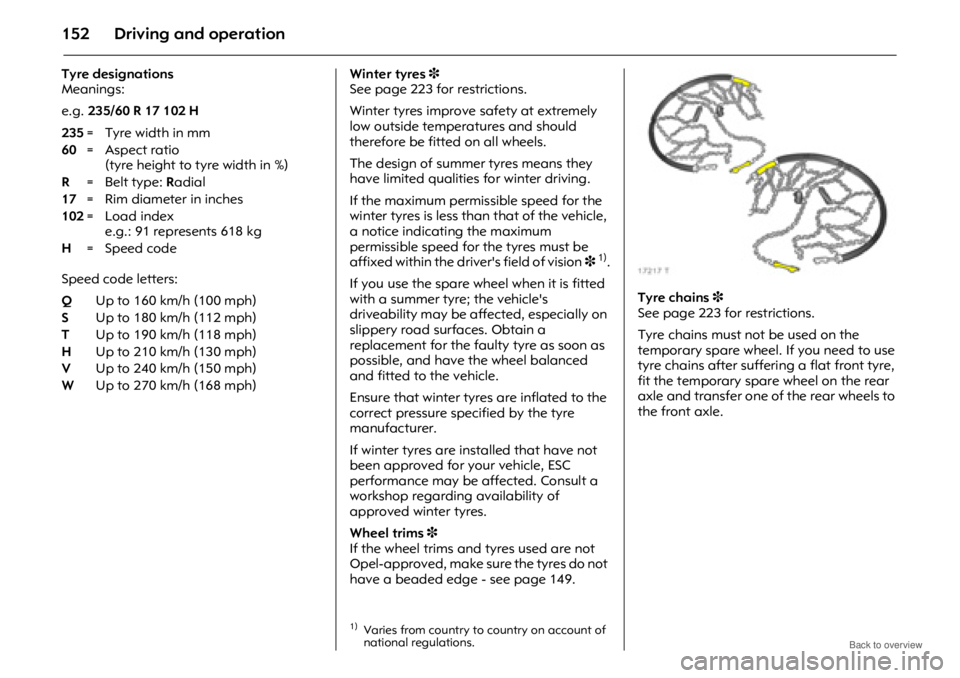height OPEL ANTARA 2009 Owners Manual
[x] Cancel search | Manufacturer: OPEL, Model Year: 2009, Model line: ANTARA, Model: OPEL ANTARA 2009Pages: 234, PDF Size: 3.01 MB
Page 8 of 234

In brief8
Adjusting seat height 3:
Raise or lower lever on outboard
side of seat
Lever pumping action
6 Seats - see page 36,
seat position – see page 38.
Adjusting head restraint height:
Press release button,
adjust height, then release
6 Head restraints - see page 39,
head restraint position – see page 39.
Fitting seat belt:
Draw seat belt smoothly from
inertia reel, guide over shoulder
and engage in buckle
The belt must not be twisted at any point.
The lap belt must lie snugly against the
body.
The backrests must not be tilted back too
far (recommended maximum tilting angle
approx. 25°).
To release belt, press red button on belt
buckle.
6 Seat belts – see pages 43 to 47,
airbag systems – see page 52,
seat position – see page 38.
upward: raises seat
downward: lowers seat
Page 13 of 234

In brief13
Steering column lock and ignition:
Turn key to position ACC.
To release lock,
rotate steering wheel slightly
Positions:
6Starting - see page 19,
electronic immobiliser - see page 22,
parking the vehicle - see page 20.
Steering wheel adjustment:
Move lever down,
adjust height and distance,
move lever up and engage
Adjust steering wheel only with vehicle
stationary and steer ing column lock
released.
Push the lever firmly upwards to ensure
that the steering wheel is locked in position.
6 Airbag systems - see page 52.
Exterior lamps
Turn light switch:
Press button:
6Headlamp warning device - see page 92,
further information - see page 94,
headlamp range adjustment 3 -
see page 97,
headlamps when driving abroad -
see page 100,
daytime running lamps 3 - see page 94.
LOCK = Ignition off
ACC = Steering unlocked, ignition off
ON = Ignition on, with diesel engine:
preheating
START = Start (transmission in neutral)
J =Off
8 =Parking lamps
9 = Dipped beam or
main beam
AUTO = Automatic dipped beam activation
3
>=Front fog lamps
r = Fog tail lamp
Page 37 of 234

Seats, interior37
Adjusting the lumbar support 3
To adjust, turn the handwheel whilst
relieving the load on the backrest.
Adjust lumbar support to suit personal
requirements. Adjusting seat height
3
To adjust, operate lever on side of seat.
Lever pumping action Electrically adju
stable front seat 3
upward: raises seat
downward: lowers seat
9 Warning
Care must be taken when operating
electrically adjustable seats. There is a
risk of injury, partic ularly for children and
a danger that articles could become
trapped.
Keep a close watch on the seats when
adjusting them.
Vehicle passengers must be informed
accordingly.
Page 38 of 234

Seats, interior38
AdjustmentThe seat position can be adjusted by
means of switches on the outboard side of
the seat.
Adjusting the longitudinal position:
Move front switch forwards/backwards.
Height adjustment:
To adjust height of front part of seat
cushion, push front part of switch up/down.
To adjust height of rear part of seat
cushion, push rear part of switch up/down.
To adjust height of entire seat cushion,
push both front and re ar parts of switch
up/down. Seat backrest adjustment:
Move upper part of rear switch forwards/
backwards.
Operate switch until desired seat position is
reached. Seat position - see next column.
After adjusting the seat, adjust height of
seat belt - see page 47.
The seat backrest must not be tilted back
too far (recommended maximum tilting
angle approx. 25°).Seat position
Adjust driver’s seat such that, with the
driver sitting upright,
the steering wheel is
held in the area of its upper spokes with the
driver’s arms slightly bent.
Slide front passenger’s seat as far back as
it will go.
The seat backrests must not be tilted back
too far (recommended maximum tilting
angle approx. 25°).
9 Warning
Disregard can lead to injuries which could
be fatal. Vehicle passengers must be
informed accordingly.
Page 39 of 234

Seats, interior39
Head restraints
To adjust head restraint height, press
release button, adjust height to suit then
release the button.
Pull head restraint up to raise. Push head
restraint down while pressing the release
button to lower the head restraint. Activ
e head restraints 3In the event of a re
ar-end impact, the
active head restraints automatically tilt
forwards. The head is more effectively
supported by the head restraint and the
danger of hyperextension in the area of the
cervical vertebra is reduced.
Do not attach objects or components that
are not approved for your vehicle to the
head restraints. These affect the protective
effect of the head re straints and can be
propelled through the vehicle in an
uncontrolled manner if the driver brakes
hard or an accident occurs.
Head restraint position
For maximum protection, the middle of the
head restraint should be at eye level. If this
is not possible for extremely tall persons,
set to highest position, and set to lowest
position for extremely small persons.
9 Warning
Disregard can lead to injuries which could
be fatal. Vehicle passengers must be
informed accordingly before moving
away.
Page 47 of 234

Seats, interior47
Seat belt height adjustmentof front seat belt upper anchorage points
zDo not adjust height whilst driving.
z Squeeze release buttons together and
slide adjuster up or down to desired
position.
z Ensure sliding height adjuster latches
into position.
Height adjuster can also be moved up
without squeezing release buttons. Removing the beltTo remove the belt, press the red release
button on the belt
buckle; the belt will
retract automatically.
Guide the belt as it retracts, to prevent
personal injury and damage to interior
surfaces.
Always ensure you position the release
button so that you can unbuckle the seat
belt quickly if necessary.
Child restraint systems 3
Opel child restraint systems are designed
specifically for your vehicle and thus
provide optimum safety for your child in
the event of an impact. The use of an Opel
child restraint system is therefore
recommended.
If a different child safe ty seat is used, follow
the manufacturer’s instructions for fitting
and use.
Selecting the right system
Your child should be transported facing
rearwards in the vehicle as long as
possible. The child’s neck area is still very
weak and in an accident they suffer less
stress in the semi-prone rearward position
than when sitting upright.
9 Warning
Disregard of these instructions may lead
to injuries or endanger life.
Page 48 of 234

Seats, interior48
NotezChildren under 12 years or under 150 cm
tall should only travel in an appropriate
child safety seat.
z Never carry a child whilst travelling in the
vehicle. The child will become too heavy
to hold in the event of a collision.
z When transporting children, use a child
restraint system that is suitable for the
child's weight, age and height.
z Ensure that the child restraint system to
be installed is co mpatible with the
vehicle type.
z You should always observe the
instructions on in stallation and use
supplied with the child restraint system. z
Do not stick anything on the child
restraint systems and do not cover them
with any other materials.
z Only allow children to enter and exit the
vehicle at the side facing away from the
traffic.
z A child restraint system which has been
subjected to stress in an accident must
be replaced.
z When the child restraint system is not in
use, secure the seat with a seat belt or
remove it from the vehicle.
z The covers of the Opel child restraint
system can be wiped clean. The following Opel ch
ild restraint systems
have been approved for installation in your
Antara:
If child restraint systems of other
manufacture are to be installed, ensure
that they conform to the appropriate
safety regulations. Group, weight and age
class
1)
1)We recommend the use of each system
until the child reaches the upper
weight limit.
Opel
system
0
0+ From birth - 10 kg,
0 - 10 months
From birth - 13 kg,
0 - 2 years Baby Safe
I From 9 - 18 kg,
8 months - 4 years Duo ISOFIX
II
III From 15 - 25 kg,
3 years - 7 years
From 22 - 36 kg,
6 years - 12 years Kid
Page 53 of 234

Seats, interior53
The front airbag system is triggered:
zdepending on the severity of the
accident,
z depending on the type of impact,
z within the range shown in the illustration,
z independently of the side airbag 3 and
curtain airbag systems.
Examples:
z Impact against a non-yielding obstacle;
the front airbags are triggered at low
vehicle speeds,
z Impact against a yielding obstacle (such
as another vehicle); the front airbags are
only triggered at a higher vehicle speed. When triggered, the driver’s and front
passenger’s airbags inflate in milliseconds
and form safety cushions for the driver and
front passenger. Forward movement of
driver and front passenger is checked and
the risk of injuries to the upper body and
head thereby subs
tantially reduced.
z No impairment of view will occur, as
airbags inflate and deflate so quickly. The front airbag system will not be
triggered in the event of:
z
the ignition being switched off,
z minor frontal collisions,
z accidents in which the vehicle overturns,
z collisions involving a si de or rear impact
where it would not be of benefit to the
occupants.
9 Warning
The front airbag system provides
optimum protection when the seat, seat
belt, backrest and head restraint are
correctly adjusted.
Adjust the driver's seat according to the
occupant's height such that, with the
driver sitting upright, the steering wheel is
held in the area of its upper spokes with
the driver's arms slightly bent.
T h e d r i v e r ’ s s e a t s h o u l d b e a s f a r b a c k a s
possible without compromising the
driver’s ability to reach the pedals,
steering wheel or controls.
The front passenger’s seat should be as
far back as possible, with the backrest
upright. Do not place the head, body,
hands or feet on the cover of the airbag
system.
Do not place objects, children or pets in
the area in which the airbags inflate.
9 Warning
Seat belts must therefore always be worn.
The front airbag system serves to
supplement the three-point seat belts.
If you do not wear your seat belt, you risk
being seriously injure d, or even thrown
from the vehicle, in the event of an
accident.
The belts help to ma intain occupants in
the correct seating position for the front
airbag system to provide effective
protection in the event of an accident.
Page 143 of 234

Driving and operation143
Control indicator for park pilotControl indicator r illuminates while
driving if there is a fault in the system.
If the acoustic signal sounds 3 times
continuously when there are no obstacles
near the front or rear bumper, there is a
fault in the system.
Have the cause of the fault remedied by a
workshop. To ensure the safety of other road users
and people in the vicinity and to avoid
damage to the vehicle, remember:
z
The park pilot should only be considered
as a supplementary function. Normal
precautions should be maintained when
reversing. Check the rear view and use
the mirrors when reversing.
z Do not push, scratch or otherwise
damage the sensors.
z Do not use high-pressure jet cleaners to
clean the sensors. Clean only with a soft
sponge and clean water.
Automatic level control 3
Automatic level control makes it possible to
keep the height of the vehicle constant
when subjected to different loads in the
rear (e.g. when passengers are occupying
the rear seats or when towing a caravan/
trailer). This significantly improves driving
conditions.
The vehicle is automatically raised at the
rear to its previous unloaded level,
increasing spring travel and ground
clearance.
Headlamp range adjustment -
see page 97.
In the event of malfunctions, do not utilise
the vehicle’s full load capacity. Have the
cause of the fault remedied by a workshop
without delay.
Page 152 of 234

Driving and operation152
Tyre designations
Meanings:
e.g. 235/60 R 17 102 H
Speed code letters: Winter tyres
3
See page 223 for restrictions.
Winter tyres improve safety at extremely
low outside temperatures and should
therefore be fitted on all wheels.
The design of summer tyres means they
have limited qualities for winter driving.
If the maximum permissible speed for the
winter tyres is less than that of the vehicle,
a notice indicating the maximum
permissible speed for the tyres must be
affixed within the driver's field of vision 3
1).
If you use the spare wheel when it is fitted
with a summer tyre; the vehicle's
driveability may be affected, especially on
slippery road surfaces. Obtain a
replacement for the faulty tyre as soon as
possible, and have the wheel balanced
and fitted to the vehicle.
Ensure that winter tyres are inflated to the
correct pressure specified by the tyre
manufacturer.
If winter tyres are installed that have not
been approved for your vehicle, ESC
performance may be affected. Consult a
workshop regarding availability of
approved winter tyres.
Wheel trims 3
If the wheel trims and tyres used are not
Opel-approved, make sure the tyres do not
have a beaded edge - see page 149. Tyre chains
3
See page 223 for restrictions.
Tyre chains must not be used on the
temporary spare wheel. If you need to use
tyre chains after suffering a flat front tyre,
fit the temporary spare wheel on the rear
axle and transfer one of the rear wheels to
the front axle.
235
=Tyre width inmm
60 =Aspect ratio
(tyre height to tyre width in %)
R =Belt type: Radial
17 = Rim diameter in inches
102 =Load index
e.g.: 91 represents 618 kg
H = Speed code
Q Up to 160 km/h (100 mph)
S Up to 180 km/h (112 mph)
T Up to 190 km/h (118 mph)
H Up to 210 km/h (130 mph)
V Up to 240 km/h (150 mph)
W Up to 270 km/h (168 mph)
1)Varies from country to country on account of
national regulations.